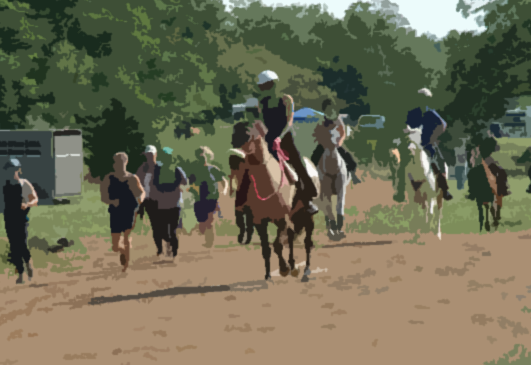Ride and Tie - A competitive sport
BRIEF HISTORY OF THE RIDE AND TIE
Bud Johns invented the sport of Ride & Tie, staging the first ever Levis Ride & Tie on June 6, 1971, near St. Helena, California. At the time, he was working for Levi Strauss & Company as public relations director. Levi’s was seeking a rugged sport to promote its similarly reputed line of outdoor clothing. As a writer, reader, and student of history, Bud had read of historic accounts where, out of necessity, two people had covered vast distances using one horse between them. One would proceed on horseback while the other ventured forth on foot. At some distance out, the rider would tie the horse to a tree and proceed on foot, thus providing his partner with a rested mount when he reached the horse. In this manner, people could cover more ground faster than if they had both walked, or if one rode and one walked. “What a concept for a race!” thought Bud, and the sport of Ride & Tie was born. Bud organized the first Levi’s Ride & Tie in 1971 at St. Helena, California. You can read, in Bud’s own words, his account of the sport’s conception and first 15 years of its history in his engaging book What Is This Madness?.

HOW IT WORKS
The sport of Ride&Tie combines trail running and endurance riding. There is a strategy to this endurance sport, which gives it an exciting and challenging flare. The objective is to get all three team members (two humans and one horse) across a 20-100 mile cross-country course by alternating riding and running. One team member starts out running, the other starts on the horse and rides down the trail as far as they think their partner can run (or walk) and still keep up a decent pace. At that strategic point, the rider stops, dismounts, ties the horse to a tree or fence post and continues down the trail on foot. The team member who started on foot gets to the horse, unties it, mounts, and rides to catch their partner up ahead. When they get to their running team member they can either stop and exchange (which is called a “flying tie”), or ride further up the trail and tie the horse and then continue running. When, where, and how a team exchanges is up to them, and this is where the strategy lies. Every trail runner has their strengths and weaknesses, and the same is true for horses. Factor all this, along with weather conditions and the topography of the course, and you can understand why Ride & Tie is as much mental as physical.
SOME RULES OF THE RIDE AND TIE
Teams consisting of two persons who are current members of the Ride and Tie Association and one horse (horse, pony or mule). The horse must be at least five years old and no pregnant or lactating mares are allowed to compete. All horses must be submitted for a pre-race examination and a post-race examination. There will be a predetermined number of vet checks where the horses will be observed and examined. Vet check criteria will be announced prior to the races start and will be determined by the Head Veterinarian after consideration of weather, terrain, and other factors. Also, horses must be presented to the veterinarians for a post-race veterinary examination within one hour of finishing. Horses must pass this examination for any member of that team to be eligible for completion awards. No abuse of the horses is tolerated.
Each team must tie its horse and switch from rider to runner and runner to rider at least six (6) times during an event. Teams may tie as many times as they desire anywhere along the trail as long as the ties do not obstruct the trail or are not made in designated “No Tie Areas.” A required tie will occur at each vet check. A team must exchange at least twice between vet checks. Where vet checks are so close that two exchanges may be impractical, the Race Director may allow one exchange between two specific vet checks. If a runner on a team has not been overtaken by his partner before the next vet check, then the runner must wait at the vet check for his/her partner to arrive in order to meet the required vet check tie.
With the exception of securing a loose horse, no person other than the team members and designated race officials may handle a team’s horse on the trail during the race. Designated team crew may work with the horse at any vet check specified by race officials to be open to crews. Race officials may require crew to obtain a pass. Only contestants may take a horse through the vet checks during the race.
It is not permissible for both members of a team to use their horse at the same time for forward movement. “Tailing” (meaning the rider dismounts, grips the horse’s tail and allows the horse to pull him/her) is allowed but it is not permissible for one team member to ride while another tails. No pacing by an un-entered horse or runner is allowed for any contestant.
Riders are responsible for their horse’s behavior prior to and during the event. If any horse becomes unruly or jeopardizes the safety of other competitors, the team may be disqualified from the event.
Teams must pass and report to any trail marshals who are positioned along the course. Competitors inadvertently off course must return to the point at which they left the marked trail and complete the course correctly. Teams must stay on the marked trail. A team has not completed the race until both human teammates and their horse have reached the finish line and violation of any of the rules could result in disqualification.
|
|



